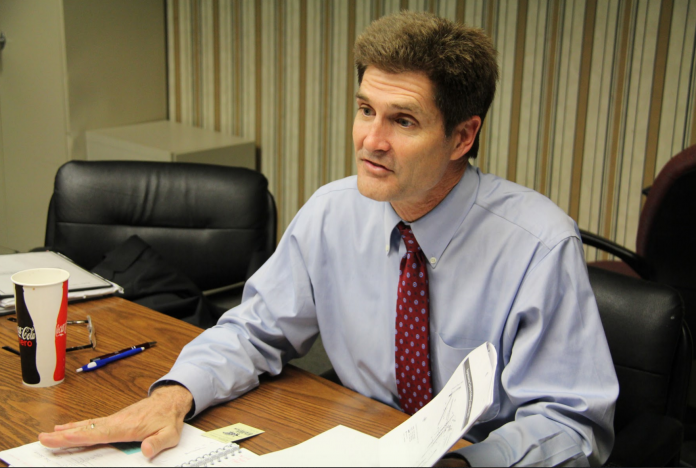Santa Clara County residents will pay a half-cent sales tax to improve roads, trains, bike and pedestrian paths to the tune of $6 billion, if a major group representing the top businesses in Silicon Valley has its way.
“We heard a rumor that traffic is back and our roads are pockmarked with potholes,” said Carl Guardino, CEO of Silicon Valley Leadership Group (SVLG), a public policy trade association that is currently lobbying for a transportation funding measure for the region.
For more than 3½ years, the group, which represents nearly 400 companies in Silicon Valley, has been working on a comprehensive transportation plan they say relieves traffic, fixes local streets and roads and increases transit options for county commuters.
The group hopes the Valley Transportation Authority (VTA) board will consider its plan at an April 22 board workshop, where it will discuss a number of transportation proposals, including results of a two-year public/private process called Envision Silicon Valley that sought input on identifying potential transportation projects that could be funded through a ballot initiative.
While SVLG did participate in the Envision Silicon Valley process, it created its own parallel plan after consulting with transportation professionals, and relevant staff at VTA and the 16 county jurisdictions.
SVLG believes it has crafted a consensus plan for the valley that is equitable to all and addresses major transportation issues.
Including big projects like the completion of the BART extension to San Jose, the proposal also includes up to $135 million worth of upgrades to the Santa Teresa and Hale corridor, and improvements to U.S. 101 and the 101-Hwy. 25 interchange in Gilroy.
The proposal also earmarks $1.2 billion for street maintenance and pothole repair across the 16 county jurisdictions. Gilroy’s allocation of that total is nearly $30 million.
SVLG’s draft expenditure plan also includes $600 million for Caltrain safety improvements and grade separations as well as another $314 million in Caltrain modernization and capacity improvements. These allocations would be made over a 30-year period.
This will benefit Gilroy and South County residents by improving the safety, capacity and efficiency of Caltrain throughout the corridor, said Chris O’Connor, SVLG senior associate in transportation and housing.
“It is estimated that the improvements funded in this measure, along with Caltrain electrification, will more than double the capacity of Caltrain,” he added.
Also benefiting Morgan Hill would be the extension of Santa Teresa Boulevard and Hale Avenue to make a seamless bypass around downtown through the west side of the city, according to Morgan Hill Councilman Rich Constantine. This project has been in the planning stages for decades, but has never gained the necessary funding. The city’s Redevelopment Agency was prepared to start digging on the Santa Teresa/Hale project in 2011, but the state shut down the agency, cutting off future property tax funding.
The completion of Santa Teresa/Hale would allow the city to implement “traffic calming” measures in order to stimulate the downtown and improve safety by diverting through traffic, Constantine said.
“A lot of the groundwork has already been laid down to put the road in,” Constantine said. “It would be very beneficial for future traffic calming and the flow of traffic we have now.”
Identified projects would be funded by a half-cent sales tax in Santa Clara County that would run for 30 years, generating nearly $6 billion.
If the VTA board moves forward with placing a transportation funding initiative on the November ballot and it passes, sales tax would start being collected in July 2017.
Guardino said there is voter support for such a sales tax measure. According to four polls conducted since August 2015, 64 to 68 percent of county voters said they were in favor of a transportation-only sales tax measure.
A 2014 study showed that people in the Bay Area spend 64 hours a year in excess traffic—above and beyond the normal commute, said Guardino, almost two work weeks stuck in traffic. Only New York and Los Angeles have worse traffic.
Up to 80 percent of Gilroy workers commute to jobs, primarily north of the city.
Greg Becker, CEO of Silicon Valley Bank, which has 2,100 employees internationally and 750 in the Bay Area, says the “noise” of people complaining about traffic, both in his company and among his clients, is getting louder.
“Housing costs and congestion are two of the big factors that come into play,” he says, in keeping companies and employees here.
“How much time you are spending in your car getting from Point A to Point B? The Bay Area will always be expensive but you have to create the opportunity for people to live in lower cost areas. If that’s taken away, you force people to think about other alternatives.”
His bank, which represents cutting edge technology companies, has opened a branch in Arizona, in part to handle the pressure of business in SIlicon Valley. “People are wanting to move down there. It’s just too expensive here.”
The funding proposal provides a mix of improvements that benefit both those who drive to work and those who ride mass transit.
“People can sit on trains and get work done,” said Becker. “For the most part, sitting in traffic is dead time. That’s why mass transportation is one of the key parts—fixing BART, getting higher capacity on Caltrain. Not just fixing the roads.”








